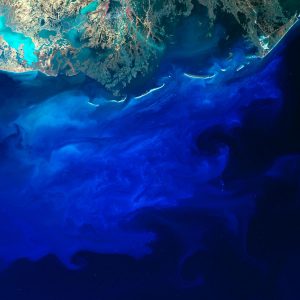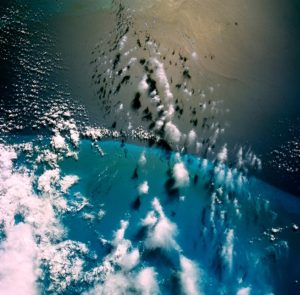
LANDSAT image from 2002: “Louisiana silt.” USGS’ interpretive caption for this picture: “Sensor: L7 ETM+; Lat/Long: 28.870/-90.521; Acquisition Date: December 28, 2002; Silt appears blue as the Mississippi River flows off the southern coast of Louisiana and into the Gulf of Mexico. The brightness and shade of blue depends on the density of the silt and the depth of the silt-carrying currents in the water. The small bright dots in the scene are fishing boats and oil platforms.” Image credit: U.S. Geological Survey.
The average Briton is unaware that 95% of the goods they buy arrived on a ship. When asked to name a “well-known British maritime personality,” most respondents said, “Captain Jack Sparrow.” These results are set forth by the Maritime Foundation as evidence of sea blindness.[i]
Duncan Redford is one of the few people so far to write about sea blindness in an academic context. [ii] He defines it as “the inability to connect with maritime issues either at an individual or political level,” though “maritime” here extends only to matters naval or mercantile.[iii] Redford notes the political appeal of “Martello towers in Nelson’s time” rather than “investing in a fleet that voters could not see.”[iv]
That is a very useful way to put it. The problem of missing what is, in one sense or another, beyond the horizon is an old one. But why not include, for example, the lawsuit and Parliamentary hearings about the slave ship Zong? The campaign against the Atlantic slave trade was surely an early example of the fight against sea blindness.
Extending the scope of the inquiry suggests some interlocutors who don’t usually keep company with First Sea Lords and geopolitical think tanks. I wonder what Greenpeace’s kayaktivists would have to say about sea blindness. Artists, like protestors, work with visibility and draw attention to what’s been overlooked. In a different way, local museums and public history advocates do the same. Visibility is the bread and butter of social media, which derives much of its energy from smart phone photos, memes, Vines, and viral videos.
Discussing “sea blindness” on its own would seem to prejudge the question. My governing principle here is that if we want to understand sea blindness, we need to think about it on a spectrum that would include, if you like, sea visibility.
When I think about sea visibility, I’m reminded of my hours watching Jacques Cousteau’s underwater documentaries as a boy. Cousteau structured his programs as, in a way, a forerunner of reality TV. The focus was on the activities of individual, named members of the crew as they pushed their exotic equipment to the limits. (I vividly remember watching one crew member go through “the bends.”)
Kim McQuaid has delved into NASA’s archives and turned up some interesting new information about Cousteau’s relationship with the American space agency in the 1970s.[v] Despite some naysayers in the agency who warned that environmentalism was just a fad and NASA shouldn’t get on board just as it was dying out, the plan was to create a Cousteau documentary about the state of the world’s oceans using footage taken by the new LANDSAT satellite. He also entered serious talks with NASA about flying on the new space shuttle as soon as it was ready.

An example of early ocean photography from space (Gemini IV, 1965). NASA’s caption: “This photograph of the Florida Straits and Grand Bahama Bank was taken during the Gemini IV mission during orbit no. 19, on June 4, 1965, with a Hasselblad camera and a 70mm lens.” Image credit: NASA.
If you had asked me, at age ten, what Cousteau did, I would have answered that he was an explorer, or perhaps a scientist. But learning about his talks with NASA, I appreciate now that he was also—and maybe most importantly—working the problem of how to make the oceans visible from whatever angle or opportunity he could find.
Following up, I suppose, on my childhood as one of Cousteau’s many armchair pupils, I just experienced the New York Times’ virtual reality app for the first time.[vi] Most of the action in “The Click Effect: Decoding the Secret Language of Dolphins and Whales” unfolds under water, so you can look down into the murky depths or up toward the sunlight as well as spinning right or left, just by tilting your smart phone.
It felt unscripted and chaotic. I worried that I might be facing away from the action, and the voiceover wasn’t providing any hints! By the end, though, I was scanning my environment in a more intuitive and assured way, lifting the iPhone until my arms fully extended above my head as I followed the diver’s progress back toward the surface. I “knew” my own position in the water and correctly sensed how to look up and track his movement.
That’s an extreme case. But lately I’ve become a little obsessed with collecting other examples. These are in no particular order, but they are chosen to illustrate the range and variety of what’s going on in our century.
- In 2010, live video streams from the ocean floor showed the continuous gush of the Deepwater Horizon oil spill hour by hour, putting pressure on President Obama in ways that would have been unthinkable a generation earlier.
- The shipping industry is “invisible” from some perspectives, but we can easily access stunning visualizations like this one.
- In the United States, groups like Divers with a Purpose and the National Association of Black Scuba Divers have won awards for their work on citizen science projects, including placing an underwater memorial at the site of a slave ship wreck.
- CGI techniques have opened up new possibilities in sea visibility, such as National Geographic’s eye-opening documentary Drain the Ocean (2009).
- Major planetary features such as undersea volcanic vents (scarcely known or understood until the 1970s) are familiar sights even to the casual viewer of nature documentaries, and today are even being integrated into models of climate change.
- Phillip Hoare has written movingly about the photographed and televised spectacle of beached whales.
- If we are prepared to think about “visibility” across the broader spectrum of sensory awareness, a 1971 scientific discovery spawned Sounds of the Humpback Whale, an album that went platinum and was later sampled in recordings by artists ranging from The Partridge Family to Laurie Anderson. Recently, David Rothenberg used underwater speakers to broadcast the sound of his clarinet to singing whales in an effort to get them to respond to his music.[vii]
- Marine conservation efforts now include the new concept of acoustic wildlife sanctuaries (as we learn, for example, that our seaborne activity is drowning out the humpback whales, who simply give up singing) and an awareness of the unintended consequences of light pollution
It’s hard to deny that we are living in an era of very high ocean visibility. That visibility is not confined to one form or format, or a single political or ecological context. It’s an area of tremendous innovation.
Future historians will puzzle over this. We could, and did, fix our gaze firmly on (and under) the sea better than ever before, in precisely the same era when it was most endangered, and we failed to pivot quickly enough to address climate change. But why? Are we showing the wrong things, or framing them incorrectly?
Elin Kelsey’s TEDx Monterey talk pairs nicely with the Maritime Foundation’s video that I opened with earlier. They’re of similar length, and both address visibility and emotional engagement with the sea, but in other ways they are quite different. She begins by blowing bubbles at the audience and challenges them to bring forth a “torrent of hope.” Kelsey, along with Nancy Knowlton and Heather Koldewey, organized a conference in the summer of 2014 where the #oceanoptimism hashtag was born, as an alternative to—as Knowlton put it—“training our students to write ever more refined obituaries of nature.”
Like other hashtags, #oceanoptimism is only as effective as the ingenuity of its users, but it has flourished as a way to flag good news and success stories. As of March 12, 2015, Trevor A. Branch reported “after 8 months, [there had been] 11,000 tweets from 5,000 people” using the hashtag. It was a natural home for National Geographic’s list of Top 15 Ocean Conservation Wins of 2015; Lydia Laurenson’s 4 Ways to Get People to Care about the Ocean; and for the “Academy Awards for the Sea”, honoring distinguished contributions in a variety of fields.
In that ocean optimism spirit, around six months ago, I started following a number of new Twitter accounts and trying to find my own answers: How are we actually engaging with the ocean today? How are we sharing images and activities? How do we use social media to invest those images and activities with meaning? If part of the problem is that the ocean is really big and we are really small, how are we bridging that cognitive and emotional gap?
In the next two posts, I’ll be writing about beachcombers, coast walkers, participants in #beachclean projects, artists, scuba divers, thrill seekers, lovers of seaside history, and self-appointed citizen scientists.
Some of their tweets are sobering; others are a little silly. What I’ve tried to keep in mind throughout is that first and maybe greatest insight of the Cultural Studies movement: Academics needed to stop deciding what sort of popular culture people should be consuming and start studying the things that they actually liked. If we’re inclined to the diagnosis of sea blindness, is it possible we’re looking in the wrong direction?
Notes
[i] The Maritime Foundation also expresses nostalgia for “We want eight and we won’t wait!” The Dreadnought era’s competitive spending sprees lie firmly in Britain’s past; consider, however, China’s expensive and confrontational agenda for the South China Sea, and the ambitious naval buildups proposed as recently as last year by Republican Presidential candidates in the US.
[ii] Thanks to my Twitter community, including @mmhoneditor, @navalhistorian , @drjamesdavey , @quintonjournals , @FjordrInfo , @mrdavidboberesq , @canadianerrant , @CathrynPearce for citations and clarification on this term.
[iii] Duncan Redford, “The Royal Navy, Sea Blindness, and British National Identity,” in Duncan Redford, ed., Maritime History and Identity: The Sea and Culture in the Modern World, (London: I.B. Tauris, 2014), 61-78, quoted page 62.
[iv] Redford, “Royal Navy,” 74.
[v] Kim McQuaid, “Selling the Space Age: NASA and Earth’s Environment, 1958-1990,” Environment and History, vol. 12, no. 2, (May 2006), 127-163.
[vi] You have to download their free VR app to your device. I also found that I needed to select the “download” option for the individual video rather than “stream” in order to see the interactive VR content.
[vii] David Rothenberg, “Whale Music: Anatomy of an Interspecies Duet,” Leonardo Music Journal, vol. 18 (2008), 47-53.










Dear Isaac
Wonderful to see you bringing a historian’s perspective to sea blindness and the movement to share conservation successes. When we launched #OceanOptimism we had no idea we were about to ignite such a twitter storm of hope. Since the tag became active on World Oceans Day (June 8, 2014) it has reached nearly 59 million followers.
Here are a couple news items that I would have included in this blog post if they’d been available at the time:
“Scientists triple known types of viruses in world’s oceans” https://news.osu.edu/news/2016/09/21/ocean-virus-catalog/
and
“Researchers capture first glimpse of important, abundant ocean microbe” http://news.ubc.ca/2016/11/22/researchers-capture-first-glimpse-of-important-abundant-ocean-microbe/
I hope that others will use this comments section to post pertinent examples of “ocean visibility” as they come across them.